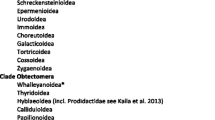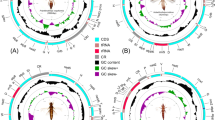The molecular evolution of the clock gene period was studied in Phlebotomine sandflies (Diptera: Psychodidae). Comparison of the synonymous and nonsynonymous substitution rates between sandflies and Drosophila revealed a significantly higher evolutionary rate in the latter in three of the four regions analyzed. The differences in rate were higher in the sequences flanking the Thr–Gly repetitive domain, a region that has expanded in Drosophila but remained stable and short in sandflies, a result consistent with the coevolutionary scenario proposed for this region of the gene. An initial phylogenetic analysis including eight neotropical sandfly species and one from the Old World was also carried out. The results showed that only the subgenus Nyssomyia is well supported by distance (neighbor-joining) and maximum parsimony analysis. The grouping of the other species from the subgenus Lutzomyia and Migonei group shows very low bootstrap values and is not entirely consistent with classical morphological systematics of the genus Lutzomyia.
Similar content being viewed by others
Author information
Authors and Affiliations
Rights and permissions
About this article
Cite this article
Mazzoni, C., Gomes, C., Souza, N. et al. Molecular Evolution of the period Gene in Sandflies . J Mol Evol 55, 553–562 (2002). https://doi.org/10.1007/s00239-002-2351-z
Received:
Accepted:
Issue Date:
DOI: https://doi.org/10.1007/s00239-002-2351-z




